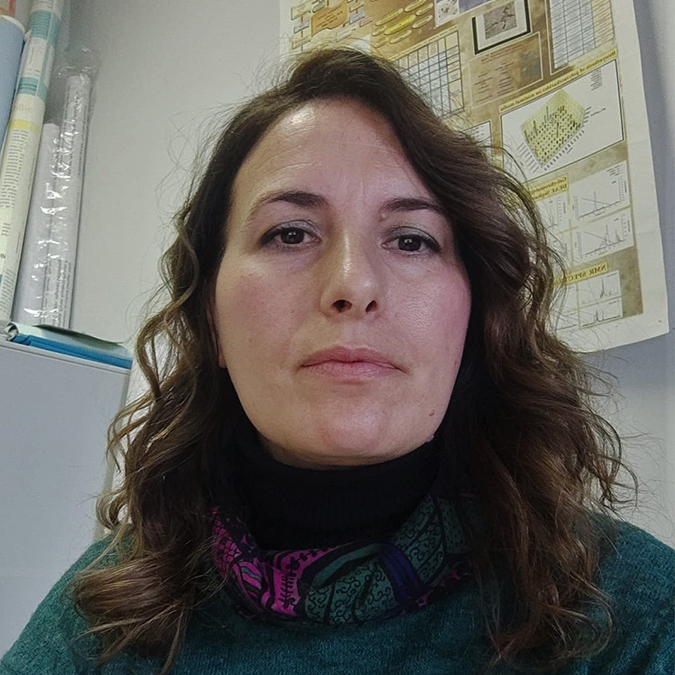Ilaria Finore
 EMail
EMail+39 081 867 5118 Home Page Orcid Scholar Researchgate WOS Scopus |
Ilaria
Finore
Institute of biomolecular chemistry Research Nutrheff Thematic Microbial technology, Biomolecular technologies (enzymatic, biochemical, molecular biology)
Research Interest and expertise in the field of nutraceuticals
and functional food
Keywords: Green Chemistry, Microbial technology; Extremophilic microorganisms; Extremozymes; Exopolysaccharides; Biotransformation; Waste biomass valorisation.
Nutraceuticals and foods of interestValorization of vegetable waste biomass not in competition with food sector. Recovery of polysaccharides from vegetable wastes. Set up of biotransformation reactions through commercial catalysts and/or extremozymes. Identification and chemical characterization of hydrolysis products. Oligosaccharides, polysaccharides; polyphenols Fields of application Pharmaceutical; Textile; Cosmetic Facilities and equipments N°1 fermentator 10 L Sartorius C plus 80.000 euro and N°1 fermentator B. Braun (Sartorius group) 50L 170.000 euros The Biostat C is a compact, laboratory scale fermenter with in-situ sterilizable 10 litres and 50 L culture vessel. It is equipped with oxygen and pH probes, four pumps, vessel with drive, digital measurement and control as well as connections to external systems. Bioprocess capabilities of the Biostat C include batch, fed-batch and continuous processes alike. N°1 Analytical nuclear magnetic resonance NMR Bruker AMX-300 MHz 600.000 euros N°1 Analytical nuclear magnetic resonance NMR Bruker AMX-400 MHz 650.000 euros N°1 Analytical nuclear magnetic resonance NMR Bruker AMX-500 MHz 700.000 euros Nuclear magnetic resonance spectroscopy is used to study the structure of molecules, the interaction of various molecules, the kinetics or dynamics of molecules and the composition of mixtures of biological or synthetic solutions or composites. The size of the molecules analyzed can range from a small organic molecule or metabolite, to a mid-sized peptide or a natural product, all the way up to proteins of several tens of kDa in molecular weight. NMR nuclear spectroscopy complements other structural and analytical techniques such as X-ray, crystallography and mass spectrometry. NMR’s advantage is the unique ability of a nuclear spectrometer to allow both the non-destructive and the quantitative study of molecules in solution and in solid state, as well as to enable the study of biological fluids. N°1 HPAE-PAD (anion exchange High pressure chromatography equipped with amperometric detector) DIONEX, 80.000 euros High-Performance Anion-Exchange Chromatography is used to separate anionic analytes which are either anions in their common form (e.g. amino acids) or analytes that can be ionized at high pH values (e.g., carbohydrates at >pH 12). Therefore, HPAE uses hydroxide-based eluents at high pH to produce anions from analytes that would not be anionic at neutral pH.The detection of underivatized analytes is performed using pulsed amperometric detection. N°1 Pharmacia AKTA FPLC Fast protein liquid chromatography 30.000 euros It is a form of liquid chromatography that is often used to analyze or purify mixtures of proteins. As in other forms of chromatography, separation is possible because the different components of a mixture have different affinities for two materials, a moving fluid (the "mobile phase") and a porous solid (the stationary phase). FPLC is generally applied only to proteins; however, because of the wide choice of resins and buffers it has broad applications. In contrast to HPLC the buffer pressure used is relatively low, typically less than 5 bar, but the flow rate is relatively high, typically 1-5 ml/min. N°1 centrifuge JA-14 BECKMAN COULTER 60.000 euros Major applications: General-purpose, large-volume and multi-tube processing. Adapters permit use of up to 30 each 15-mL tubes and up to 72 each 3-mL tubes. N°1 centrifuge A JLA-8.1000 BECKMAN COULTER 60.000 euros Major applications: General purpose, large-volume processing, pelleting of bacteria, cell organelles, viruses, and precipitates. N°1 ultracentrifuge OPTIMA XPN 90, 80.000 euros The Optima XPN generates centrifugal forces for the separation of particles. Classified S, it can be used with all currently manufactured Beckman Coulter rotors for floor-model preparative ultracentrifuges.The Optima XPN, its rotors and its labware are designed, manufactured, and tested as an integrated system to ensure optimal performance and safety for lab. N°1 Microtiter plate reader (Biorad) 8.000 euros With its unique imaging capabilities, monochromator design, and spectral scanning feature (which eliminates the need for filters), the xMark™ Microplate Absorbance Spectrophotometer can find the best wavelength within a broad range for any photometric application. The xMark Spectrophotometer is also flexible enough to read all standard microplates, from 6- to 1,536-well formats.The xMark Spectrophotometer can perform a wide range of end-point and kinetic applications with spectral scanning. N°1 Inverted Optical Microscope Nikon Eclipse TE200 equipped with color digital video camera ExwaveHAD- Sony, 20.000 euros The Eclipse E200-LED is a built-to-last, top-quality biological microscope ideal for basic laboratory use or as a student microscope for educational purposes. With its newly developed LED Eco-Illumination system, the laboratory microscope produces brighter, sharper, crisper, and clearer images for a noticeably enhanced view. |

